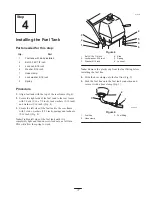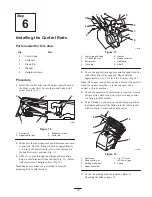
4
•
Before using, always visually inspect to see that
guards, and safety devices, such as deflectors and/or
grass catchers, are in place and working correctly.
•
Before using, always visually inspect to see that the
blades, blade bolts and cutter assembly are not worn or
damaged. Replace worn or damaged blades and bolts
in sets to preserve balance.
Starting
•
Disengage all blade and drive clutches and shift into
neutral before starting the engine.
•
Do not tilt mower when starting the engine or
switching on the motor, unless the mower has to be
tilted for starting. In this case, do not tilt it more than
absolutely necessary and lift only the part, which is
away from the operator.
•
Start the engine or switch on the motor carefully
according to instructions and with feet well away from
the blade(s) and not in front of the discharge chute.
Operation
•
Never mow while people, especially children, or pets
are nearby.
•
Mow only in daylight or in good artificial light.
•
Stay alert for holes in the terrain and other hidden
hazards.
•
Never direct discharge of material towards bystanders.
•
Avoid operating the equipment in wet grass, where
feasible.
•
Do not put hands or feet near or under rotating parts.
Keep clear of the discharge opening at all times.
•
Never pick up or carry a lawn mower while the engine
is running.
•
Use extreme caution when reversing or pulling a
pedestrian controlled lawn mower towards you.
•
Walk, never run.
Slopes:
–
Do not mow excessively steep slopes.
–
Exercise extreme caution when on slopes.
–
Mow across the face of slopes, never up and down
and exercise extreme caution when changing
direction on slopes.
–
Always be sure of your footing on slopes.
Use low throttle settings when engaging the
traction–clutch, especially in high gears. Reduce speed on
slopes and in sharp turns to prevent overturning or loss of
control.
Stop the blades if the lawn mower has to be tilted for
transportation when crossing surfaces other than grass and
when transporting the lawn mower to and from the area to
be mowed.
Do not operate the engine in a confined space where
dangerous carbon monoxide fumes can collect.
Stop the engine
–
whenever you leave the lawn mower.
–
before refueling.
–
before removing the grass catcher.
–
before making height adjustment unless adjustment
can be made from the operator’s position.
Stop the engine and disconnect the spark–plug lead or turn
off and remove key
–
before clearing blockages or unclogging chute.
–
before checking, cleaning or working on the lawn
mower.
–
after striking a foreign object, inspect the lawn
mower for damage and make repairs before
restarting and operating the lawn mower.
–
if lawn mower starts to vibrate abnormally (check
immediately).
Use care when using sulkies, and
–
use only approved drawbar hitch points.
–
limit loads to those you can safely control.
–
do not turn sharply; use care when reversing.
–
do not carry passengers.
Watch out for traffic when crossing or near roadways.
Before leaving the operator’s position
•
disengage the power take–off and lower the
attachments.
•
change into neutral and set the parking brake.
•
stop the engine and remove the key.
Maintenance and storage
•
Keep all nuts, bolts and screws tight to be sure the
equipment is in safe working condition.
•
Do not use pressure cleaning equipment on machine.
•
Never store the equipment with gasoline in the tank
and inside a building where fumes can reach an open
flame or spark.
•
Allow the engine to cool before storing in any
enclosure.





































